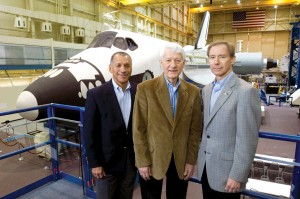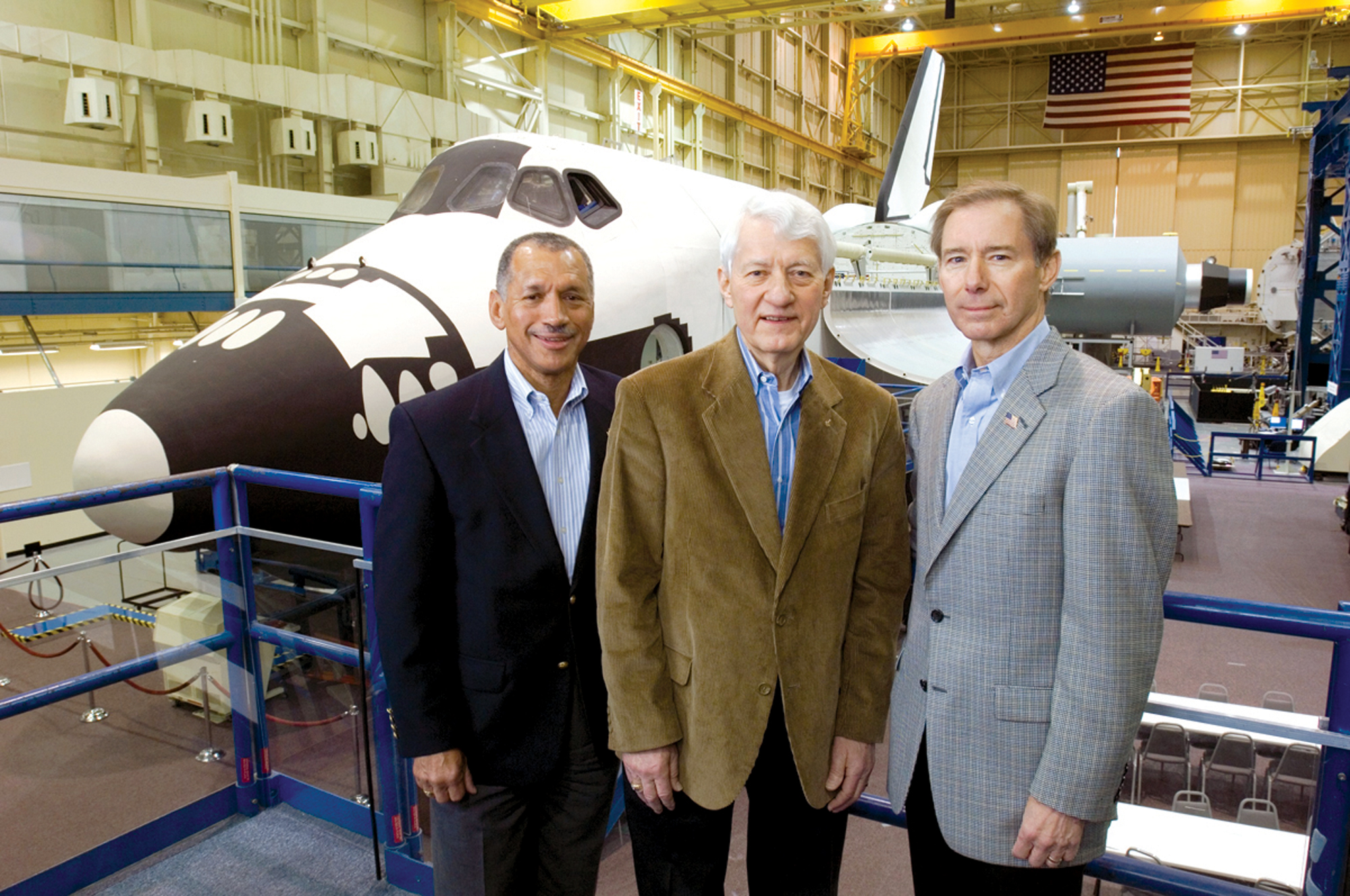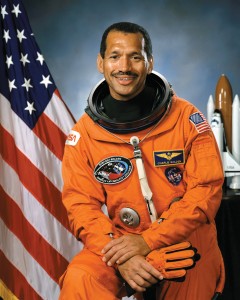
Charles Bolden, Henry Hartsfield and Brewster Shaw will join such American space heroes as Neil Armstrong, John Glenn, Alan Shepard, Jim Lovell, Sally Ride and John Young when they are enshrined during a public ceremony at the Kennedy Space Center
Space history will be made on May 6, 2006, as three of America’s finest space shuttle commanders are honored and inducted into the U.S. Astronaut Hall of Fame. The commander of the first joint U.S. and Russian space shuttle mission, the commander of Space Shuttle Discovery’s maiden voyage and the commander of the mission that paved the way for construction of the International Space Station will increase the number of space explorers enshrined in the Astronaut Hall of Fame to 63.
Charles Bolden, Henry Hartsfield and Brewster Shaw will join such American space heroes as Neil Armstrong, John Glenn, Alan Shepard, Jim Lovell, Sally Ride and John Young when they are enshrined during a public ceremony at the Kennedy Space Center Visitor Complex.
The inductees were selected by a committee of current Hall of Fame astronauts, former NASA officials and flight directors, historians, journalists and other space authorities in a process administered by the Astronaut Scholarship Foundation. This is the fifth group of space shuttle astronauts named. Earlier inductees came from the Mercury, Gemini, Apollo, Skylab and Apollo-Soyuz programs.
To be eligible for induction, an astronaut must have made his or her first flight at least 20 years before the induction year and be retired from NASA’s astronaut corps at least five years. A candidate must be a U.S. citizen, NASA-trained and have orbited the earth at least once. In balloting, committee members evaluate not only an individual’s flight accomplishments, but also how he or she contributed to the success and future success of the U.S. space program in post-flight assignments.
Charles Bolden
Charles Bolden has flown on four Space Shuttle missions, logging 680 hours in space. During his first mission in 1986 on STS-61C, the crew deployed a SATCOM satellite and conducted experiments in astrophysics and materials processing aboard the Materials Science Lab.
He piloted STS-31 in 1990 to deploy the Hubble Space Telescope and conduct a variety of mid-deck experiments. The crew used a variety of cameras including IMAX for Earth observations from their record-setting shuttle altitude of 400 miles.
On STS-45, aboard Atlantis, Bolden commanded a crew that included two European Space Agency payload specialists for the first Spacelab mission dedicated to NASA’s Mission to Planet Earth. Bolden also commanded the historic first joint U.S./Russian space shuttle mission, STS-60, in 1994, which involved the participation of a Russian cosmonaut as a mission specialist to conduct science activities.
Bolden left NASA to return to active duty in the U.S. Marine Corps as the deputy commandant at the Naval Academy. General Bolden later served as president of American PureTex Water. He has served on numerous boards including the Astronaut Memorial Foundation.
Henry Hartsfield

Henry Hartsfield became an astronaut in 1969 and is a veteran of three space shuttle flights with 483 hours in space.
Henry Hartsfield became an astronaut in 1969 and is a veteran of three space shuttle flights with 483 hours in space. He was pilot of Space Shuttle Columbia’s fourth and final test flight, STS-4. After seven days of rigorous tests, Columbia landed on July 4, 1982, to the cheers of one million people and President Reagan.
On STS-41D, Shuttle Discovery was seconds from liftoff when there was a failure of the orbiter’s back-up general purpose computer. Commander Hartsfield and his crew members reacted quickly to make the vehicle safe. After repairs were made, Discovery roared into orbit on August 30 for its maiden voyage. The crew earned the name “Icebusters” when Hartsfield successfully removed a hazardous ice buildup from the orbiter using the Remote Manipulator System.
Hartsfield returned to orbit aboard Challenger STS-61A on Oct. 30, 1985, commanding a crew of five Americans, two Germans and a Dutchman for a week of round-the-clock research in a cargo bay workshop to complete more than 75 scientific experiments in the European-built Spacelab.
After his third shuttle flight, Hartsfield held a number of administrative assignments with NASA. He is vice president of aerospace engineering services at Raytheon Corp. in Houston.
Brewster Shaw
A veteran of three space shuttle missions, Brewster Shaw has logged 533 hours of space flight. Shaw’s first space trip was in 1983 as pilot of Columbia STS-9, which carried the European-built Spacelab in its cargo bay. Six astronauts worked in shifts conducting more than 70 multi-disciplinary scientific and technical investigations. This mission carried the first international shuttle crew and the heaviest payload to be returned to Earth in the shuttle’s cargo bay.
Shaw was in command of Atlantis in 1985 on STS-61B, with the mission of testing techniques for constructing a space station in orbit. After seven astronauts perished in the explosion of Challenger in 1986, Shaw served as a staff member of the presidential commission that investigated the accident and led the Return to Flight team responsible for implementing safety modifications to the shuttle fleet and later became NASA’s space shuttle program manager.
Shaw returned to space in 1989 as commander of Columbia on STS-28, a classified Department of Defense mission. Today, he’s the chief operating officer of United Space Alliance.
Astronaut Scholarship Foundation
The Astronaut Scholarship Foundation, originally known as the Mercury Seven Foundation, participated in creating a venue where space travelers could be remembered, with the opening of the U.S. Astronaut Hall of Fame in 1990.
Since 2002, Delaware North Companies Parks and Resorts at KSC, Inc., which operates the Kennedy Space Center Visitor Complex, has run the U.S. Astronaut Hall of Fame. Today, the Astronaut Scholarship Foundation serves as a consultant in the operation of the hall of fame, which includes supervising the selection of astronauts for enshrinement.
The foundation’s main purpose is to aid the U.S. in retaining its leadership role in science and technology by providing scholarships to college students pursuing these degrees. To date, the foundation has awarded more than $2 million to deserving scholars.
Induction Ceremony
The public is invited to witness heroes honoring heroes at the U.S. Astronaut Hall of Fame Induction Ceremony. Astronauts scheduled to attend include John Young, Robert Crippen, Buzz Aldrin, Charles Duke and Scott Carpenter.
The ceremony is included as part of admission to the Kennedy Space Center Visitor Complex. Special Astronaut Hall of Fame Induction Weekend packages are available.
For more information regarding the U.S. Astronaut Hall of Fame Induction Ceremony, visit [http://www.kennedyspacecenter.com] or call 321-449-4444. For more information regarding the Astronaut Scholarship Foundation, visit [http://www.astronautscholarship.org] or call 321-269-6119.













